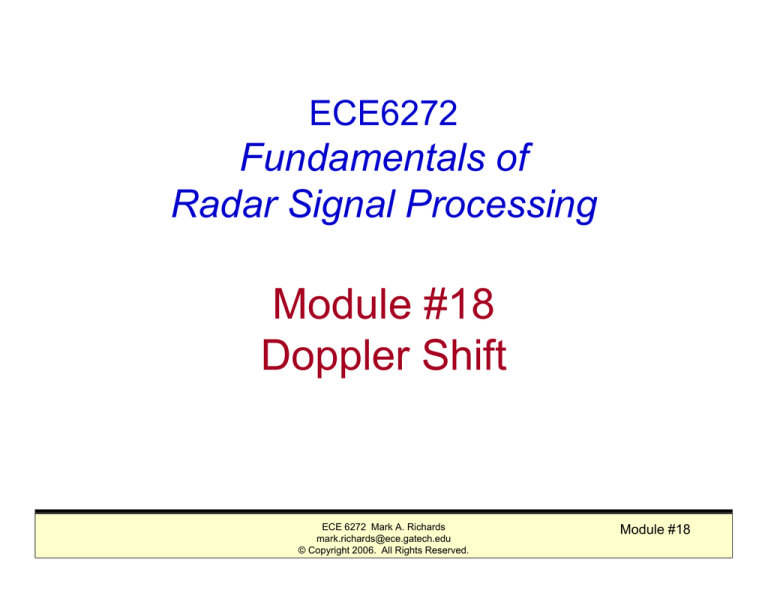
ECE6272
Fundamentals of
Radar Signal Processing
Module #18
Doppler Shift
ECE 6272 Mark A. Richards
mark.richards@ece.gatech.edu
© Copyright 2006. All Rights Reserved.
Module #18
Relativistic Doppler Shift
• Consider a monostatic radar
transmitting at frequency Ft
• Scatterer moves towards the radar
with velocity v ((“closing”
closing target)
• Special relativity predicts the
received frequency will be
1+ v c
Fr =
Ft
1− v c
ECE 6272 Mark A. Richards
mark.richards@ece.gatech.edu
© Copyright 2006. All Rights Reserved.
Module #18
Simplifying for Low Velocity - 1
• v/c is always small
– Mach 2 ((~680
680 m/s) v/c = 2.3x10
2 3x10-6
– LEO (“low earth orbit”) satellite (~7.6 km/s)
v/c = 2.5x10-5
• Expand denominator in binomial series:
−1
Fr = (1 + v c )(1 − v c ) Ft
2
= (1 + v c ) 1 + ( v c ) + ( v c ) + Ft
2
= 1 + 2 ( v c ) + 2 ( v c ) + Ft
ECE 6272 Mark A. Richards
mark.richards@ece.gatech.edu
© Copyright 2006. All Rights Reserved.
Module #18
Simplifying for Low Velocity - 2
• Discard quadratic and higher-order
terms in (v/c):
Fr = 1 + 2 ( v c ) Ft
• Doppler shift is the change in
frequency:
2v
2v
FD = + Ft = +
λt
c
ECE 6272 Mark A. Richards
mark.richards@ece.gatech.edu
© Copyright 2006. All Rights Reserved.
Module #18
Values of Doppler Shift
• Mach 2 aircraft (~680 m/s) causes 4.5 kHz
shift at L band ((1 GHz))
• LEO satellite causes 507 kHz shift at X band
B d
Band
Frequency
(GHz)
Doppler shift (Hz)
for v = 1 m/s
L
1
6.67
C
6
40.0
X
10
66.7
Ka
35
233
W
95
633
ECE 6272 Mark A. Richards
mark.richards@ece.gatech.edu
© Copyright 2006. All Rights Reserved.
Module #18
Radial Velocity
y
v
φ = 90º
FD = 0
v
φ
FD = +
boresig
ght
directio
on
• Doppler shift
is determined
b th
by
the radial
di l
component
of velocity for
a monostatic
radar
2v
λ
cos φ
x
radar antenna
ECE 6272 Mark A. Richards
mark.richards@ece.gatech.edu
© Copyright 2006. All Rights Reserved.
Module #18
Envelope and Bandwidth Effects
• Radar waveforms are not
monochromatic sinusoids, but have finite
bandwidth
– almost always 10% or less (usually much
less) of carrier frequency
• Effect of Doppler on bandwidth usually
completely
l t l iinsignificant
i ifi
t
Br = 1 + 2 ( v c ) Bt
• Time dilation or contraction of pulse
envelope similarly insignificant
ECE 6272 Mark A. Richards
mark.richards@ece.gatech.edu
© Copyright 2006. All Rights Reserved.
Module #18
Non-Relativistic Approach
• Because v/c is small, relativistic effects are
insignificant
– simpler approach will give correct expressions
for Doppler shift and other motion-induced
phase modulations
• Consider a general time-varying range
from radar to target of R(t); then
2R ( t )
y (t ) = x t −
c
ECE 6272 Mark A. Richards
mark.richards@ece.gatech.edu
© Copyright 2006. All Rights Reserved.
Module #18
Doppler Shift Example - 1
• Target moves toward radar at
constant velocity v, implying
R ( t ) = R0 − vt
– R0 is range at time t = 0
• Constant
Constant-frequency
frequency complex
exponential is transmitted:
x ( t ) = a ( t ) exp [ j 2π Ft t ]
ECE 6272 Mark A. Richards
mark.richards@ece.gatech.edu
© Copyright 2006. All Rights Reserved.
Module #18
Doppler Shift Example - 2
• Received signal becomes
2 ( R0 − vt )
2 ( R0 − vt )
y (t ) = b t −
exp j 2π Ft t −
c
c
4π
Round-trip
2 R0
R0
≈ b t −
exp − j
phase
c
λ
t
Carrier
2v
Delayed
exp + j 2π t exp [ j 2π Ft t ]
Envelope
λt
Doppler
term
ECE 6272 Mark A. Richards
mark.richards@ece.gatech.edu
© Copyright 2006. All Rights Reserved.
Module #18
End of Module #18
ECE 6272 Mark A. Richards
mark.richards@ece.gatech.edu
© Copyright 2006. All Rights Reserved.
Module #18
